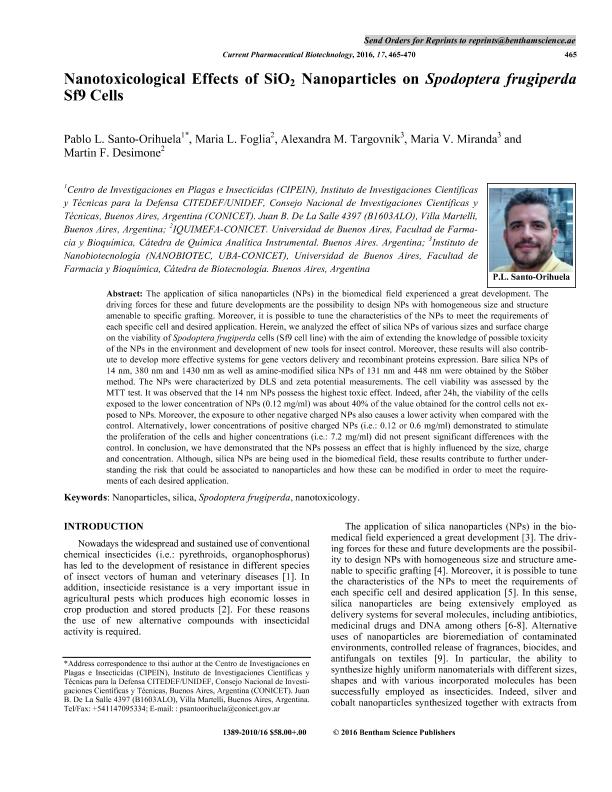Artículo
Nanotoxicological Effects of SiO2 Nanoparticles on Spodoptera frugiperda Sf9 Cells
Santo Orihuela, Pablo Luis ; Foglia, María Lucía
; Foglia, María Lucía ; Targovnik, Alexandra Marisa
; Targovnik, Alexandra Marisa ; Miranda, Maria Victoria
; Miranda, Maria Victoria ; Desimone, Martín Federico
; Desimone, Martín Federico
 ; Foglia, María Lucía
; Foglia, María Lucía ; Targovnik, Alexandra Marisa
; Targovnik, Alexandra Marisa ; Miranda, Maria Victoria
; Miranda, Maria Victoria ; Desimone, Martín Federico
; Desimone, Martín Federico
Fecha de publicación:
03/2016
Editorial:
Bentham Science Publishers
Revista:
Current Pharmaceutical Biotechnology
ISSN:
1389-2010
Idioma:
Inglés
Tipo de recurso:
Artículo publicado
Clasificación temática:
Resumen
The application of silica nanoparticles (NPs) in the biomedical field experienced a great development. Thedriving forces for these and future developments are the possibility to design NPs with homogeneous size and structureamenable to specific grafting. Moreover, it is possible to tune the characteristics of the NPs to meet the requirements ofeach specific cell and desired application. Herein, we analyzed the effect of silica NPs of various sizes and surface chargeon the viability of Spodoptera frugiperda cells (Sf9 cell line) with the aim of extending the knowledge of possible toxicityof the NPs in the environment and development of new tools for insect control. Moreover, these results will also contributeto develop more effective systems for gene vectors delivery and recombinant proteins expression. Bare silica NPs of14 nm, 380 nm and 1430 nm as well as amine-modified silica NPs of 131 nm and 448 nm were obtained by the Stöbermethod. The NPs were characterized by DLS and zeta potential measurements. The cell viability was assessed by theMTT test. It was observed that the 14 nm NPs possess the highest toxic effect. Indeed, after 24h, the viability of the cellsexposed to the lower concentration of NPs (0.12 mg/ml) was about 40% of the value obtained for the control cells not exposedto NPs. Moreover, the exposure to other negative charged NPs also causes a lower activity when compared with thecontrol. Alternatively, lower concentrations of positive charged NPs (i.e.: 0.12 or 0.6 mg/ml) demonstrated to stimulatethe proliferation of the cells and higher concentrations (i.e.: 7.2 mg/ml) did not present significant differences with thecontrol. In conclusion, we have demonstrated that the NPs possess an effect that is highly influenced by the size, chargeand concentration. Although, silica NPs are being used in the biomedical field, these results contribute to further understandingthe risk that could be associated to nanoparticles and how these can be modified in order to meet the requirementsof each desired application.
Palabras clave:
Nanoparticles
,
Toxicity
,
Spodoptera Frugiperda
,
Silica
Archivos asociados
Licencia
Identificadores
Colecciones
Articulos(IQUIMEFA)
Articulos de INST.QUIMICA Y METABOLISMO DEL FARMACO (I)
Articulos de INST.QUIMICA Y METABOLISMO DEL FARMACO (I)
Articulos(NANOBIOTEC)
Articulos de INSTITUTO DE NANOBIOTECNOLOGIA
Articulos de INSTITUTO DE NANOBIOTECNOLOGIA
Citación
Santo Orihuela, Pablo Luis; Foglia, María Lucía; Targovnik, Alexandra Marisa; Miranda, Maria Victoria; Desimone, Martín Federico; Nanotoxicological Effects of SiO2 Nanoparticles on Spodoptera frugiperda Sf9 Cells; Bentham Science Publishers; Current Pharmaceutical Biotechnology; 17; 3-2016; 465-470
Compartir
Altmétricas



